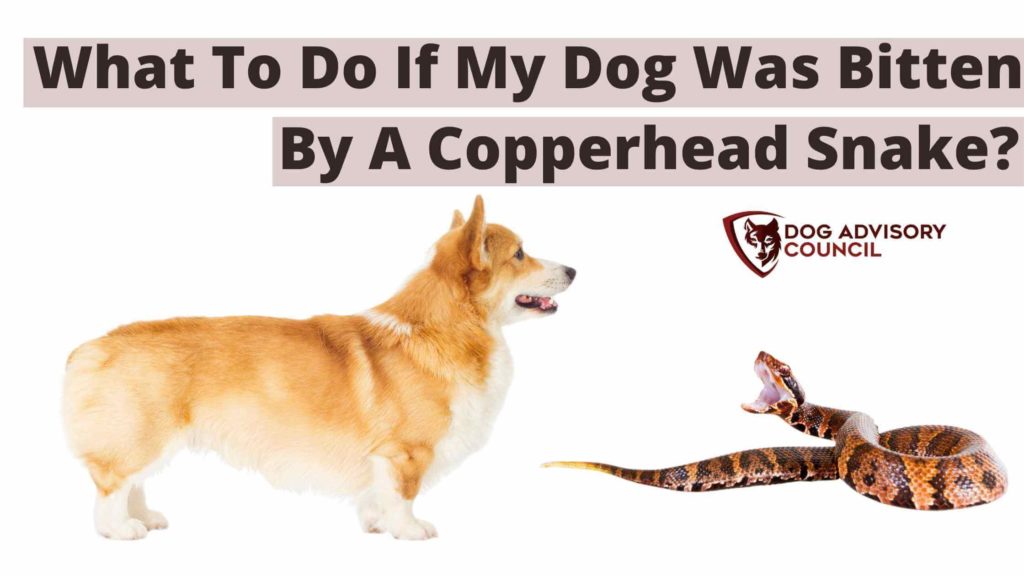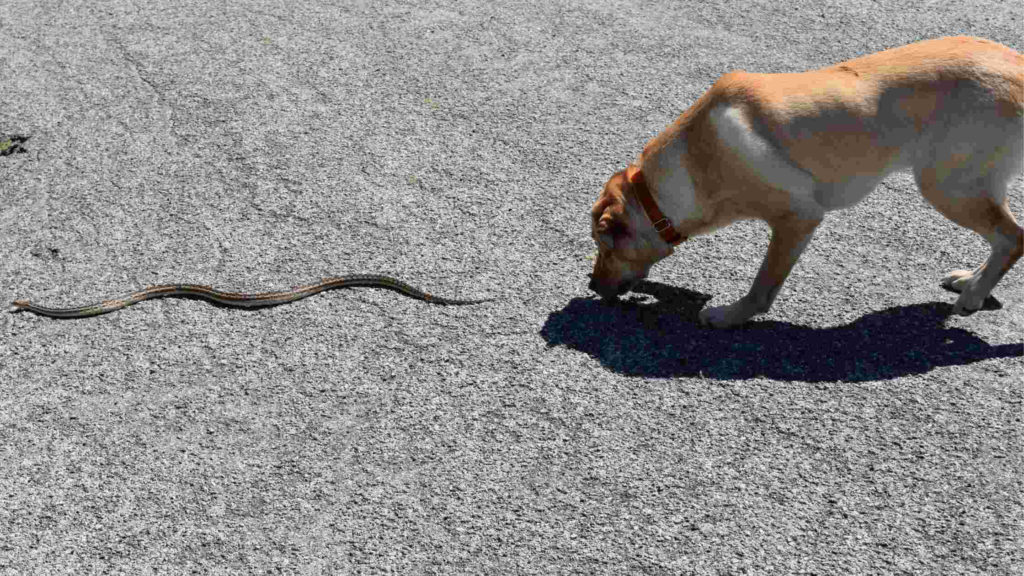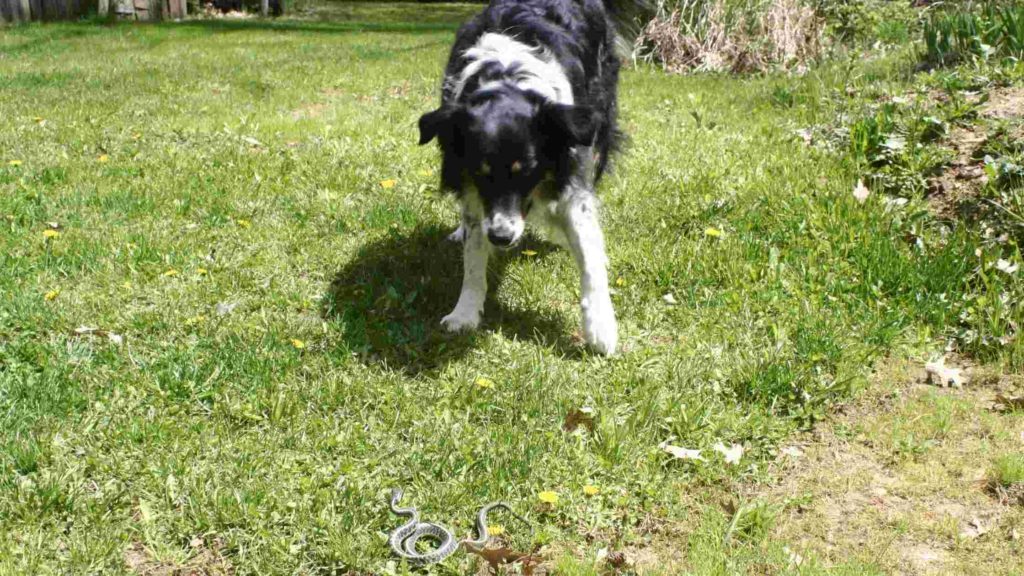
Having your dog yelp and run back to you, terrified, is alarming. Whether you see the snake bit yourself and know it’s a Copperhead, or you just want to be safe in case it happens, below is everything you need to know if your dog was bitten by a copperhead snake.
A bite by a Copperhead snake counts as an emergency, and you will need to get your dog to a vet right away. The sooner you get them treated, the easier their recovery will be. Mild reactions to a Copperhead bite include a possible bacterial infection and localized swelling. However, moderate and severe reactions are common with these poisonous snakes. These can include seizures and even death if not treated correctly and in time.
How to identify a Copperhead snake
It only makes sense to ensure the type of snakebite, right? Copperheads are identified by:
- A triangular head
- Short length (compared to other snakes)
- Hourglass spots
These also freeze when spotted instead of slithering out of sight. They will want to hide in their environment, even if it seems illogical to us.
How serious is a Copperhead snake bite?
As introduced above, a Copperheadbite is always going to be an emergency. Even if it ends up being a dry bite (more on that later), time is of the essence to help ensure that it is, in fact, a harmless bite and that your dog has the antibiotics needed to recover without complications.
For your dog’s ultimate safety, assume that every bite from a Copperhead is potentially life-threatening, and get them to an emergency vet as soon as possible.
How poisonous is a Copperhead for dogs?
The degree of how poisonous it is depends a the snake and on the dog. Here are some consideration factors
A snake that has just bitten something else will be weaker and have less venom available. This will mean a less poisonous bite. A young snake will also have less control over its venom, which works in your favor. A weaker poison will give your dog a better chance of recovery.
Your dog’s health will also impact how a bite’s poison impacts them. Small dogs, puppies, and senior dogs are all going to react more to the same amount of poison as large, full-grown, and healthy dogs would. If your dog has any health conditions or is weakened by age. In that case, they have a stronger chance of needing serious intervention to save them.
Unless your vet tells you otherwise, assume that your dog will need emergency intervention to save them. If you don’t think this way, your dog may suffer unnecessarily.
How do vets treat a Copperhead bite?
So, how do vets actually treat a bite from a Copperhead? It will mostly depend on whether they get a wet or dry bite. A wet bite is a bite in which venom is inserted into your dog, and a dry bite is when it’s just a “warning shot” or a regular snake bite.
The first thing that vets will do is check if it was a poisonous bite or a regular bite. At this point, they’ll check your dog for symptoms of the poison and will most often give them an antivenom treatment.
After that, your vet will address the snake bite location itself. If your dog was bitten on the face or the neck, for example, the vet will want to see if there are any breathing obstructions. The same goes for potential damage to organs and blood vessels. This is important to minimize any kind of permanent damage to your dog.
Often, dogs who are bitten in the eye or on the tongue can have permanent damage and have the strongest likelihood of not surviving the attack.
Even in the best-case scenario with a bite in one of these areas, your dog will need long-term observation and intense care to save their life. Once the emergency care is given, your vet will care for your dog in these main areas:
- Observation for possible complications
- Fluids and support
- General wound care
Observation for possible complications
A huge part of dog Copperhead bite treatment is going t be watching for any reactions that might be delayed. Even after being given initial treatment, dogs might have strong reactions as the venom works its way through the body.
Your vet will want to keep them for several hours in most cases in case they need more intervention.
Fluids and support
As a result of the poison, dogs can deal with hypotension and shock. It is a strong reaction in the body, after all. Vets will offer supportive fluids and antihistamines to help them deal with the actual shock of the bite and its pain.
The stronger their body is, the better they’ll recover, and the faster your dog will back to their wonderful self!
General wound care
Snakes have deep bites, and a Copperhead is no exception. Your vet will often recommend antibiotic shots and/or a topical product to help minimize swelling and help prevent any kind of infection from the bite and its location.
As you can see, a vet will do a lot of things to care for your dog properly, which is part of why skipping a visit to the vet after a bite is so important!

How long does it take for Copperhead venom to work on a dog?
If your dog has a wet bite, a bite where a Copperhead will inject its venom into your dog, there are going to be a few stages. For clarity, the stages of venom from a Copperhead are going to be broken down within three time zones:
- Within minutes of the bite
- Within an hour of the bite
- Within 36 hours of the bite
Within minutes of the bite
Let’s assume that you are there when your dog gets bitten by a Copperhead. Within minutes of envenomation, you will notice visual signs that your dog is reacting to this poisonous snake bite.
Common symptoms at this stage include visual swelling of the bite site, indicators and signs of pain as your dog starts to feel the bite and its venom kick in, and bruising as well as oozing from the bite itself.
These are all signs that you need to get your dog to the vet right away, no matter how mild it looks. This is especially important if the bite location could impact their breathing and other critical functions!
Within an hour of the bite
Within the first hour of the bite, whether you saw it or not, a dog would need to receive the antivenom treatment if the vet recommends it. The venom will damage the central nervous system and tissue around the bite itself within that first hour. If there is no antivenom administered, your dog will have permanent damage.
Antivenom isn’t always required, even if your dogi sr exacting to it. But vets will need to assess and decide within that first hour to decide what is best for your dog’s well-being.
This first hour is also going to be helpful for your dog’s recovery in general care. This includes those things we talked about already, like fluids and careful observation.
Within 36 hours of the bite
The first 36 hours after a bite will help you understand better just how serious your dog’s reaction could be permanent. For example, if you don’t know that a Copperhead has bitten your dog, those 36 hours can go by without you even knowing it.
Or, some assume that it’s a dry bite and choose not to bring their dog in to have it looked at professionally.
In these cases, your dog can have permanent central nervous system damage, scarring, and more since they don’t receive timely treatment. In cases where there is central nervous system damage, or organ damage (depending on the bite location), it can be fatal.
Fatal bites only occur about 10% of the time, but this is why timely vet care is essential after a Copperhead snake bites your dog.
How long does it take for a Copperhead bite to heal on a dog?
The location and the kind of bite will determine how long it will take for it to heal fully on your dog, but here are some guidelines to help!
- Without hours of the bite
- Within days of the bite
- Within weeks of the bite
Without hours of the bite
If your dog is treated quickly after being bitten, they will receive the antivenom, if needed, and the supportive care that their bodies need to help them stay stable after the physical shock of the bite.
Even though they will require close observation, typically at the vet’s office, their body will have the care and attention needed, and your dog will already be on the road to recovery.
Within days of the bite
Depending on the location and complexity, your dog will be released from the vet sometime on the same day or days after the bite. Their antivenom treatment will be completed, their body will be pumped full of treatments, and they will “pass all the tests” that the vet offers.
This means that the only recovery now is of the bite location itself. Your vet will often give your dog antibiotic treatment for several weeks and possibly a check-up. This is just to make sure that everything is recovering as it should be.
Within weeks of the bite
After several weeks have passed, your dog will have recovered as much as possible. This includes any kind of damage to their organs or body. Some damage may become permanent, depending on their reaction. It also speaks to the positive healing, which includes finishing the antibiotic treatment and the bite mark itself healing and fading.
There is no standard healing time for a Copperhead bite, but these stages will help you learn what to expect.

Copperhead bite symptoms on dogs
There are some symptoms that most pet parents will notice if their dog got bitten by a Copperhead (or another snake, for that matter) even if they weren’t there for the bite itself:
- Visible signs of pain or distress
- A swelling wound
- Oozing and bleeding from the wound
- Drooling
- Lethargy
- Difficulty breathing
- Shivering and shaking
- Collapse/loss of consciousness
Any time you see any of these symptoms, it’s a good idea to check your dog over for bites (sometimes there might be more than one) and then call your vet right away to get your dog in to be checked out.
Copperhead dry bite symptoms
As briefly mentioned above, sometimes Copperheads will bite with a “warning shot,” which means it’s just a “normal” snake bite with no envenomation. This is commonly called a dry bite. In that case, the symptoms will be just as serious but more focused on the bite itself:
- Swelling at the bite location
- Bruising and/or bleeding
- Bite location reactions in the body
This last point refers, of course, to where the bite is on the body and any complications it may cause (a bite to the face can cause swelling and difficulty breathing, seeing, eating, etc.).
Do dogs need antivenom for Copperhead bites?
Often, vets won’t administer an antivenom to your dog after a Copperhead bite. They’ll monitor them and use antibiotics, antihistamines, and fluids instead. An antivenom is only required if your vet thinks that your dog’s body needs a treatment specifically to counteract the venom rather than support the body.
There are a lot of factors that go into making this decision, so don’t assume that the antivenom is overkill. If your vet recommends it, take it.
Can a dog survive a Copperhead bite without treatment?
If your dog has a dry bite, they can survive a Copperhead bite without treatment. If it is a vet bite, they can also survive without treatment — but it will be much harder. They will need to recover entirely on their own, which can put more strain on their already stressed body.
This is not an excuse to skip a trip to the vet after a confirmed bite by a Copperhead! The only time to skip a vet trip is if your vet specifically tells you to do so while monitoring for specific symptoms.
How do you treat a Copperhead bite on a dog at home?
Tips for properly caring for your dog’s Copperhead bite at home include:
- Following your vet’s direction
- Keeping your dog from picking at the wound
- Keep the wound clean
- Apply or feed treatments or medications as needed
Most importantly: when in doubt, ask your bet. Sometimes dogs can have symptoms again even after treatment, so always have an emergency vet on call!
Can I apply Benadryl on a Copperhead bite on my dog?
You can apply regular strength Benadryl to a Copperhead bite on your dog, as long as you are sure it doesn’t contain acetaminophen and/or pseudoephedrine. Don’t combine the two if your vet offers you a different product for the bite itself. Use what is prescribed.
You can offer your dog Benadryl capsules, too, following the exact requirements as above. However, this is more to ease symptoms while getting them to a vet. It will not counteract any kind of poison from the venom!
How to prevent my dog from being bitten by a Copperhead snake
There is no such thing as protecting your dog from everything, and this includes the possibility of a bite from a Copperhead snake! However, tips include:
- Keeping your dog on a leash at all times outside
- Obedience training to keep your dog under control
- Staying on walking paths and away from snake hideouts
- Observing for snakes as you walk
These preventative tips will help you do everything you can to protect your dog from a potential snake bite.
How do you keep Copperheads out of your yard?
Many dogs get bitten by Copperheads in their own yards. Keeping your yard free of these dangerous snakes, for their sake and your own, comes down to making it uninviting for them! Tips include:
- Keep your grass mowed
- Plant a barrier of snake-repellent plants
- Consider a snake fence
- Keep sheds and woodpiles to your yard’s perimeter
Most importantly, remember this when it comes to spotting a Copperhead: there is often more than one where you see one. Be careful where you step!
In conclusion
A Copperhead bite can be either venomous or not. Both bites will require a vet’s attention as soon as possible after the bite to ensure that your dog has the support that he needs to recover smoothly and without complications.
Without timely treatment, a venomous Copperhead bite, or even a dry bite in the wrong location, can be fatal. Know the locations and the signs to look for when it comes to the potential dangers of a Copperhead bite.
Helping your dog recover from a Copperhead snake involves acting quickly and efficiently with the support of your vet to help them get back to normal with no long-term consequences. Take this seriously to protect your dog’s well-being!
